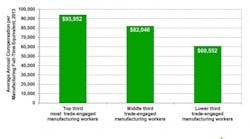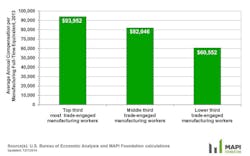Several research studies through the years have found that export-intensive industries pay more on average than industries that are not.
One such analysis, reported by the MAPI Foundation, shows that "employees in the most trade-intensive industries, where combined exports and imports amount to at least 64% of domestic industrial output, earn an annual compensation package averaging $93,952."
That's more than 50% higher than in the least trade-engaged sectors, according to the report.
Trade Engagement Pays Through Higher Wages
Cliff Waldman, MAPI's Chief Economist, injects a note of caution, however: "It's one thing to look at correlations, to note that exporters tend to pay more. It's another to say causation, that exporting causes higher wages."
"You have to be careful with movements in wages," he adds. "They can come from existing workers making more money, or they can come from a shift from less skilled to more highly skilled, and thus higher wage, workers. Right now, I can't say that either one of them is proven."
Waldman points out that exporting markets are among the most competitive."It's the major leagues of competitiveness. What's clear to me, and seems clear in the few reports that have been done, is that exporting creates creative pressures, which creates needs for automation, for efficiency, for product and process innovation, which, as we know, creates a skills premium."
Research by the U.S. International Trade Commission economist David Riker, supports a similar view. A study he completed in 2010 and updated in 2015, found a significant earnings premium in export-intensive manufacturing industries--a 19% premium for blue collar workers and a 9.9% premium for white collar workers.
In the 2010 report, Riker notes that export-intensive industries must invest in technology and capital to be competitive. This investment "increases the productivity of workers and contributes to higher earnings," according to the report.
- Industries in the most trade-engaged category account for more than half of U.S. manufacturing trade.
- The middle group of the three pays an average $82,046 in annual wages and benefits.
- Industries in middle group account for 38% of U.S. manufacturing trade.
- The industries with the least trade engagement pay $60,552 on average.
- Industries with the least trade engagement account for only 10% of U.S. manufacturing trade.
- The premium pay of trade-engaged industries extends to other manufacturing and service companies in the supply chain. Employers at these companies—where jobs are directly supported by exports—enjoy higher pay than their peers at companies that are solely domestic.





